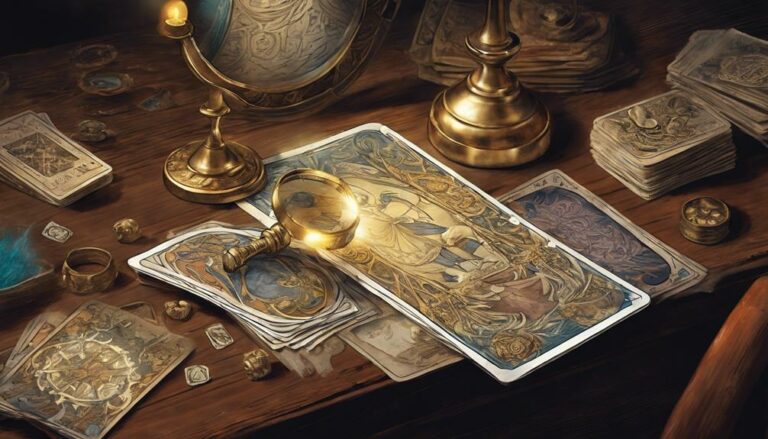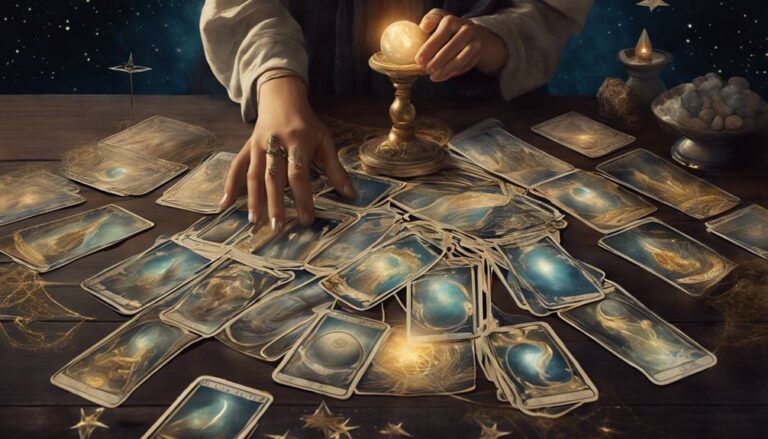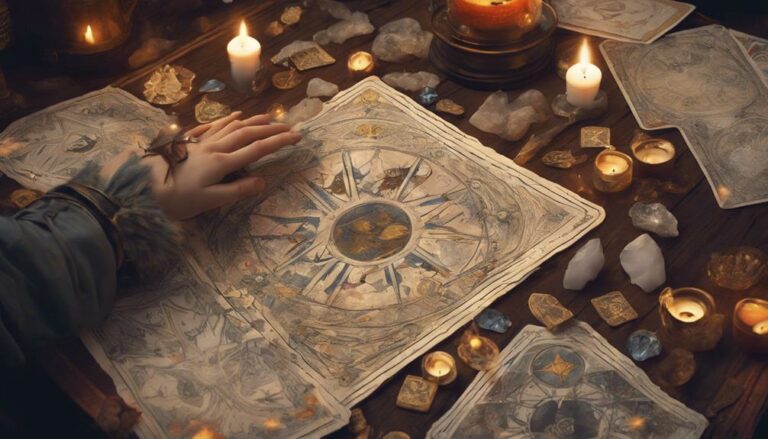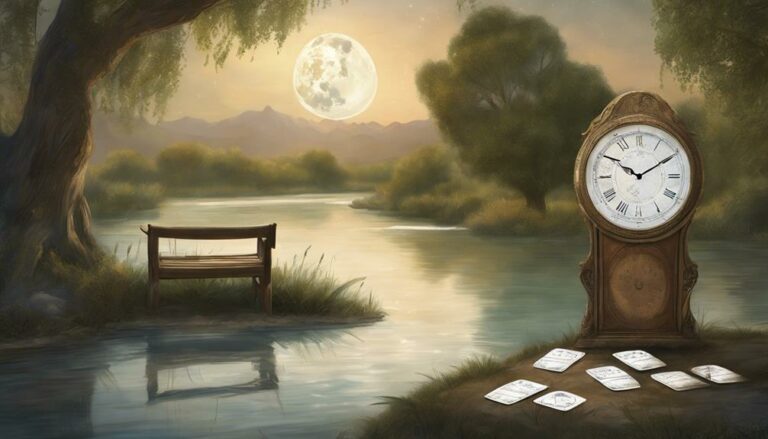As a tarot enthusiast, I have always been captivated by the profound symbolism and archetypal patterns that emerge from the cards. In this article, we will delve into the fascinating world of tarot through the lens of Jungian psychology. By exploring the depths of the collective unconscious and analyzing the intricate symbolism in tarot imagery, we will uncover the hidden layers of meaning and gain a deeper understanding of ourselves and the world around us. Join me on this transformative journey as we integrate the wisdom of both tarot and Jungian psychology.
Table of Contents
ToggleKey Takeaways
- Tarot archetypes hold immense power for personal transformation and self-discovery.
- Tarot cards tap into the collective unconscious, revealing hidden layers of meaning and connection in the human psyche.
- Analyzing tarot symbolism through a Jungian lens taps into the collective wisdom of humanity and offers guidance and illumination.
- Tarot cards serve as tools for self-reflection and personal growth, allowing us to explore and integrate our shadow self for self-acceptance and self-discovery.
The Role of Archetypes in Tarot Interpretation
The role of archetypes in tarot interpretation can’t be underestimated. Tarot archetypes hold immense power in guiding personal transformation and self-discovery. These archetypes, which are deeply rooted in the collective unconscious, represent universal symbols and patterns that resonate with our subconscious minds. They tap into the essence of human experience, providing a framework for understanding the complexities of life.
When conducting a tarot reading, the influence of archetypal patterns on tarot spreads becomes apparent. Each card embodies a specific archetype, and the arrangement of these cards in a spread creates a narrative that reflects the individual’s journey. The archetypes present in the spread interact with one another, revealing the underlying dynamics at play in the individual’s life. This interaction provides insights into the individual’s strengths, challenges, desires, and potential for growth.
Furthermore, tarot archetypes serve as catalysts for personal transformation. They act as mirrors, reflecting aspects of ourselves that we may not be fully aware of. By engaging with these archetypes, we open ourselves up to a deeper understanding of our own psyche. The tarot becomes a tool for self-reflection and self-discovery, allowing us to confront and integrate different aspects of our being.

Exploring the Collective Unconscious in Tarot Readings
Exploring the collective unconscious in tarot readings reveals hidden layers of meaning and connection. The unconscious symbolism in tarot is a powerful tool for tapping into the depths of the human psyche and uncovering profound insights. Tarot cards, with their archetypal imagery, have the ability to transcend time and culture, speaking to universal themes and truths that reside within us all.
The collective unconscious, as described by Carl Jung, is the reservoir of shared experiences and inherited knowledge that exists within every individual. It is a wellspring of symbols and archetypes that shape our thoughts, emotions, and behaviors. When we engage with tarot cards, we are delving into this vast sea of collective wisdom.
Each card in the tarot deck is rich with archetypal imagery, representing universal themes such as love, death, transformation, and power. These symbols are deeply ingrained in our collective unconscious, and they resonate with us on a profound level. Through the process of tarot reading, we are able to tap into these archetypes and access their transformative power.
By examining the unconscious symbolism present in tarot readings, we can uncover hidden patterns and connections that may not be immediately apparent. The images and symbols on the cards act as a mirror, reflecting back to us aspects of ourselves that may be hidden or unconscious. This process of self-reflection and exploration can lead to profound personal growth and self-awareness.
Analyzing Tarot Symbolism Through a Jungian Lens
Analyzing tarot cards through a Jungian lens reveals hidden layers of meaning and connection. Tarot symbolism holds a powerful tool for personal growth and self-discovery. The archetypal images depicted in the cards tap into the collective unconscious, the shared reservoir of human experiences and ancestral memories. By delving into the unconscious symbolism present in tarot readings, we can uncover profound insights about ourselves and the world around us.
Jung believed that the symbols found in tarot cards are not random, but rather manifestations of universal archetypes. These archetypes represent fundamental human experiences and emotions that are common to all individuals. When we interpret the symbols in tarot readings, we are tapping into the collective wisdom of humanity.
Each card in the tarot deck is rich in its own symbolism. The Major Arcana cards, in particular, depict powerful archetypes such as the Fool, the Magician, and the High Priestess. These archetypes embody different aspects of our psyche and can offer guidance and illumination on our journey towards self-discovery.
By exploring the unconscious symbolism in tarot readings, we can gain a deeper understanding of ourselves and our experiences. The cards act as mirrors, reflecting our innermost thoughts, desires, and fears. Through this process of introspection, we can unlock hidden potentials and overcome obstacles that may be hindering our personal growth.
Understanding the Shadow Self in Tarot Card Meanings
To gain a deeper understanding of your shadow self in tarot card meanings, you can explore the hidden layers of your psyche. Tarot cards serve as powerful tools for self-reflection and personal growth, allowing you to uncover the aspects of yourself that may be hidden or repressed. This process, known as shadow work, involves delving into the darker, less conscious parts of your being in order to integrate them into your conscious awareness.
The shadow self, a concept introduced by renowned psychologist Carl Jung, represents the parts of ourselves that we often reject or deny. It is the repository of our repressed desires, fears, and unresolved emotions. By engaging in shadow work, we embark on a journey of self-discovery, accepting and integrating these hidden aspects of our psyche.
Tarot card meanings can provide valuable insight into our shadow self. The symbolism present in the cards acts as a mirror, reflecting the hidden aspects of our being back to us. The cards reveal the archetypal energies that reside within us, both light and dark, encouraging us to confront and embrace our shadows.
Through self-reflection and introspection, we can begin to unravel the layers of our psyche and bring our shadow self into the light. This process of uncovering hidden aspects is not always easy or comfortable, but it is essential for personal growth and wholeness. By exploring our shadow self in tarot card meanings, we embark on a transformative journey of self-acceptance and self-discovery.

Integrating Jungian Psychology With Tarot Practice
As you delve into the practice of integrating Jungian psychology with your tarot practice, you’ll discover a deeper understanding of your subconscious mind and its influence on your life. This integration offers a powerful tool for personal growth through tarot exploration. By incorporating the principles and concepts of Jungian psychology, we can tap into the vast reservoir of unconscious symbolism in tarot readings.
Jung believed that the tarot cards are archetypal symbols that reflect the collective unconscious, a realm where universal patterns and themes reside. Through the process of tarot reading, we can access this collective unconscious and gain insight into our own personal unconscious. By exploring the imagery and symbols in the tarot cards, we can unlock the hidden aspects of our psyche and bring them to light.
Through this integration, we can uncover the deeper layers of our being and gain a greater understanding of ourselves. The tarot becomes a mirror that reflects our inner world, allowing us to explore the unconscious aspects of our personality, desires, fears, and motivations. By working with these symbols, we can bring our unconscious patterns into consciousness and initiate personal transformation.
Integrating Jungian psychology with tarot practice is a profound journey of self-discovery and personal growth. It invites us to explore our unconscious mind, unravel its mysteries, and integrate its wisdom into our conscious awareness. Through this process, we can gain profound insights, heal old wounds, and embrace the fullness of our being. The tarot becomes a tool for self-reflection, self-awareness, and self-empowerment.
Frequently Asked Questions
Can Tarot Cards Predict the Future?
I don’t believe tarot cards can predict the future. From an ethical standpoint, it raises questions about manipulating people’s lives. Skepticism and a scientific perspective suggest that tarot is more about introspection and self-reflection.
What Is the Significance of the Different Suits in Tarot Readings?
The different suits in tarot readings have a symbolic representation that helps guide interpretation techniques. Each suit holds its own meaning and can be connected to personal experiences, adding depth and insight to the reading.
How Can One Use Tarot Cards to Interpret Dreams?
To interpret dreams with tarot cards, I explore the symbolism of the cards and how they relate to my dream imagery. Integrating tarot and dream analysis aids personal growth, revealing unconscious patterns and archetypal influences.
Do Different Tarot Decks Have Different Meanings?
Yes, different tarot decks can have different meanings. These variations arise from diverse interpretations and cultural influences. The symbolism of each deck reflects the unique perspectives and beliefs of its creators and users.
Can Tarot Cards Be Used for Psychological Self-Reflection?
Sure, tarot cards can be a powerful tool for personal growth and symbolic exploration. They provide a mirror to our subconscious, helping us delve into the depths of our psyche and gain insight into ourselves.
Conclusion
In conclusion, delving into the world of tarot through a Jungian perspective is like embarking on a journey into the depths of our own psyche. Like a brave sailor navigating through stormy seas, we are confronted with archetypal symbols that mirror our deepest fears, desires, and unconscious patterns. Through the lens of Jungian psychology, we uncover the hidden treasures of our collective unconscious, shedding light on the shadows that lurk within. By integrating these insights into our tarot practice, we embark on a transformative voyage, navigating the turbulent waters of self-discovery and personal growth.










